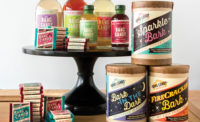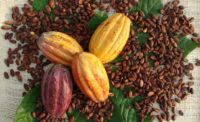Dietsch Brothers has been a member of Retail Confectioners International (RCI) since the 1980s, but the company history dates back to the late 1920s when three brothers joined forces to open a candy and ice cream store in Findlay, Ohio.
Nearly 100 years and two more generations later, this family business uses some of the same old-fashioned processes they used back then, such as the process of starch moulding to create their meticulously crafted starch-moulded marshmallows.
First appearing in RCI’s member magazine Kettle Talk, Natalie Beall and Bryan Smith of Dietsch Brothers illustrate how Dietsch Brothers makes these classic confections using an antique starch press to create a uniform-shaped product — a process that takes two days in its entirety.
Step 1: Fill the trays
The process begins by filling wooden trays with moulding starch and leveling them out. Moulding starch is drier than traditional cornstarch, which allows the marshmallow to dry out a little more as it sets up.
Step 2: Press the trays
Once filled and leveled, each wooden tray is inserted into a press. A manual lever is pulled down a couple times to tightly compress and shape the starch revealing 144 dome cavities, a mirror image of the metal mould plate attached to the press.
Step 3: Prepare the gelatin
Dietsch Brothers’ traditional marshmallow recipe involves preparing a batch of gelatin about an hour before it’s needed. As gelatin absorbs liquid, each granule becomes enlarged, a process that’s known as "blooming."
Step 4: Add sugar and water
Once the gelatin has time to activate, it is added to a mixture of cooked sugar and water. Corn syrup, nougat crème and vanilla are added and the entire mixture is spun in their Hobart mixer.
Step 5: Funnel the mixture into starch moulds
The candy makers hand funnel the marshmallow mixture into the starch moulds. One batch of marshmallow will make approximately 1,700 pieces.
Step 6: Let marshmallows dry
Each batch dries for about 16 hours. The longer the marshmallows sit, the stiffer they get.
Step 7: Add chocolate
The next morning, each tray of marshmallows is dumped, sifted and thoroughly brushed before receiving a blanket of chocolate in the enrober. It is very important to thoroughly brush the starch off the marshmallows before receiving a chocolate coating, so the chocolate adheres better when enrobed. Too much starch residue left on the marshmallow creates holes in the chocolate coating. Despite causing an unsightly appearance, it can also cause the marshmallow to dry out faster.
The result of Dietsch Brothers’ time-honored craft is an army of uniform chocolate-covered marshmallow domes made with the care and attention of skill candy craftsmen and women who are a treasured part of the candy industry.
For confectioners and chocolatiers who appreciate the art of candy making, whether that’s utilizing state-of-the-art mechanics or dipping chocolates by hand, Retail Confectioners International (RCI) has provided a forum for retail confectioners, like Dietsch Brothers, to connect, learn and build their sweet businesses for over 100 years.
Attending RCI’s Annual Convention & Industry Expo is a great opportunity to connect with fellow confectioners and suppliers who share the similar goals of offering something truly special to their customers.
Confectionery professionals of all shapes, sizes and specialties are invited to attend RCI’s Annual Convention & Industry Expo July 25-29, 2022 at the David L. Lawrence Convention Center in Pittsburgh, Pennsylvania. This week-long event will feature a two-day tradeshow, educational sessions, confectionery tours and unique connection opportunities. Registration for this event will open soon. Visit retailconfectioners.org/annual to sign up to receive a notification email when registration opens. For more information about becoming a member of RCI, visit retailconfectioners.org/join or call 417-883-2775.





